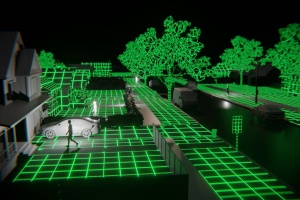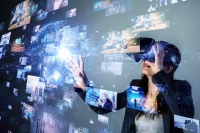Difference between revisions of "Bliss"
| Line 10: | Line 10: | ||
===History=== | ===History=== | ||
| − | + | Simulated experiences were born when it was discovered that humans interpret data better when it is visualized pictorially as opposed to numerically. In the past, science and engineering data sets were presented in numeric tables and/or matrices. Then, when we started making graphs and illustrations to represent data it became evident that we needed to come up with better ways to produce these data sets. Engineers then created tools to utilize computer graphics, which led to the advent of [https://en.wikipedia.org/wiki/Computer-generated_imagery CGI] | |
Revision as of 21:22, 3 April 2021

Bliss (2021) is a new, drama-science fiction, Prime Original film on Amazon Prime. The movie was directed by Mike Cahill and stars actors such as Salma Hayek and Owen Wilson.[1] Bliss follows the main character, Greg Wittle, as his mundane life turns upside down when he discovers that everyone around him is part of a computer simulation except, his new companion, Isabel. Computer Simulations being a replacement for reality, the algorithms involved holding biases, mental consequences for users, and equal access to the technology are ethical implications with regards to computer simulations that are explored throughout the film.
Contents
Plot
Bliss begins in a dreary office with the middle-aged, and recently divorced father of two, Greg Wittle (Owen Wilson) sketching his "dream" house in extreme detail. Due to his lack of concentration, among other reasons, Greg is told to go to his boss’s office to be fired. Then, Greg accidentally kills his boss. In a panic, he flees to the bar across the street where he meets the disheveled, homeless Isabel Clemens (Salma Hayek). Isabel tells Greg that they are living in a simulation and nothing around them is real. Isabel, then, is somehow able to manipulate the situation in Greg's favor, ultimately gaining Greg's trust. After that, Greg and Isabel explore poverty-ridden Los Angeles. They take the yellow crystal to give them control of the simulated world i.e., they appear to have telekinetic abilities, which they start off using for mischief, but then expand into committing high level crimes, which they interpret as "living freely." While Greg and Isabel explore the power of these yellow crystals, Greg's daughter Emily becomes very worried about her dad and begins to investigate what he is up to, although his son, her brother does not share the same enthusiasm. Emily doesn't stop searching until she finds him; when they begin to interact, it is then clear that he has lost all sense of reality and time because Emily tells him about all the events he has missed, such as her graduation. She hands him her graduation photo with her phone number on the back; she realizes that he has been living a drug induced life and tells him to call her when he is ready. Eventually, Greg’s beliefs of Isabel's simulation begin to waver, so Isabel decides to take him back to the real world via the blue crystals. Prior to ingesting the blue crystals, she explains to him that they are very rare crystals and that they need to ingest ten each, throughout the nostrils via some kind of mechanical apparatus. However, she does not have enough crystals, but they proceed anyway, disregarding the risks she made obvious. On arriving back to what she calls "the real world," Greg wakes up in a semi-reclined seat in a futuristic world, with an apparatus attached to his face, which made some kind of connection through his nose and up into his brain. The other end of the connection led to a large container in the shape of a cube, with what appeared to be multiple human brains suspended in a water-like liquid. As Greg scans the futuristic room in which he has awoken, it is then apparent that he is part of some kind of experiment ran by Isabel with multiple participants. Isabel also awakens, but none of this is new to her so she immediately heads over to one of the scientists gathering data and asks to be filled in on anything new. As the pair begin exploring this alternate reality, Greg does not remember any of it, so she brings him to, what should be, a very familiar landscape. Isabel takes him to what he would daydream about and draw at work, which was his dream house on the hill side. Isabel then begins to fill him in on the period of darkness that humanity went through before making the significant scientific breakthroughs that ultimately shaped the utopian world that they were currently in. She explained to him that the three pillars of creation were automation, synthetic biology, and asteroid mining and that the advent of these three pillars allowed humans to reach an age of enlightenment in which everyone became more happy, innovative, and productive. At this point, Greg is convinced that this is the perfect world, but when they attend a party to celebrate the success of Isabels simulation, the simulated world begins to meld with the real world, leading Greg and Isabel to go back into the simulated world. The film ends with Greg choosing between the two worlds, two versions of himself.
Computer Simulations

A computer simulation is a computer program that uses a model of a real system to duplicate the functional relationships within the real system.[2] The technology that created the simulated world in the film was known as the Brainbox. All of the real participants were placed into the same world for research purposes. The computer-created people were known as FGP (fake generated person). The idea behind the world was to explore the not-so-perfect pieces of oneself, without the fear of death. The FGPs are periodically respawned if they ever die. A similar concept is developed in the TV series Westworld.[3] Virtual Reality is a form of a computer simulation in which the user experiences and can interact with the artificial 3D world created by the simulation.[4]
History
Simulated experiences were born when it was discovered that humans interpret data better when it is visualized pictorially as opposed to numerically. In the past, science and engineering data sets were presented in numeric tables and/or matrices. Then, when we started making graphs and illustrations to represent data it became evident that we needed to come up with better ways to produce these data sets. Engineers then created tools to utilize computer graphics, which led to the advent of CGI
Ethical Issues
Replacement for Reality
The technology seen in the film is a futuristic version of the virtual reality devices seen and commonly used today.[5] As this technology gets more and more realistic, it can replace human interaction, and cause the user to think the simulation is real, as seen in the film.[6]
Unintended Bias
In the film, Greg became attached to the simulated world, and it became his real reality. This was an unintended effect of the Brainbox simulation. New technological breakthroughs, if not designed carefully and thoughtfully, like the Brainbox, can have unintended results.[13] Microsoft engineers created a Twitter bot to chat with Millenials, but within hours of release, it began posting racist, sexist, and Holocaust-denying tweets from the algorithm that was teaching it how to respond.[13] The engineers intended the bot to be a fun way to get Millennials involved in Twitter, but instead they created a controversial bot.[13] Langdon Winner describes how the simple design of an overpass in Long Island caused years of subtle discrimination of poor people and African Americans, who at the time normally used public transit.[14] Winner says that one software developer can put bias into a given product to lend intended or unintended consequences.[14] It only took one engineer’s bias to created discrimination in society.[13] Algorithms collecting micro and macro data are being designed to make decisions on real people. [15]
Creating simulations can be defined as "the science of predicting or manipulating future states of single or multiple physical phenomena and living organisms within an existing or proposed built environment." [16] This sums up what Isabel was so desperately trying to achieve. It then becomes obvious that opinions about the conditions one might apply to judge how the simulation will be utilized will be heavily influenced by the philosophical and ethical assumptions of the person making the judgement.
Consequences for Users
The usage of virtual reality/simulation technology can have psychological impacts on the user.[17] In the film, Greg and Isabel live life without consequences. Greg can kill his boss and get away with it. If someone is living their perceived life with no penalties, they are more likely to do more negative things which can lead to negative reactions after.[17] A psychological study has been done to learn if real, lasting consequences can occur from interacting with virtual reality games. The researchers discovered that an individual playing a virtual reality game can experience intense negative emotions. They followed up and concluded that the participants utilizing the virtual reality had negative emotions that lasted up to a day as compared to participants playing a similar game on a laptop.[17] The findings show that the negative emotions created during an immersive experience can cause memory rumination leading to a more depressed mood.[18]
Equal Access Right
The ideal world that Greg and Isabel are in is utopian. Everyone has the time and money to explore their passions, and climate change has been reversed. The purpose of Isabel’s research is to show that her simulation technology should be a human right. At that time in the film, there was not positive consensus with the benefits of her technology for various reasons, equal access to all being one of them. Equal access to information and technology being a human right is an ongoing debate.[19] Two terms that are often used when discussing this debate are equality and equity. Formally, equality is defined as the quality or state of being equal.[20] Equity is defined as justice according to natural law or right, specifically, freedom from bias or favoritism.[21] There is a balance between reaching equality and equity in regard to access to information and technology. If there is too much of a focus on equity, there will be backlash from those who resent such programs as ‘unfair’.[22] Achieving this balance is a goal of librarians and other scholars involved in information technology, since they play a large role in creating change.[22]. To create fair and equal access, there needs to be justice from equity.[22]
References
- ↑ Bliss. (2021). Amazon Prime. Retrieved 11 March 2021, from https://www.amazon.com/Bliss-Salma-Hayek/dp/B08RMNMGNB
- ↑ T. (2017, April 27). Computer simulation. Retrieved March 11, 2021, from https://www.britannica.com/technology/computer-simulation
- ↑ Kornhaber, S. (2018, June 27). The virtual afterlife of 'westworld' might not be fiction. Retrieved March 25, 2021, from https://www.theatlantic.com/entertainment/archive/2018/06/westworlds-virtual-afterlife-wont-always-be-fiction/563741/
- ↑ Mitchell, C. (2020, November 21). Virtual reality. Retrieved March 11, 2021, from https://www.investopedia.com/terms/v/virtual-reality.asp
- ↑ VR home. (n.d.). Retrieved March 11, 2021, from https://arvr.google.com/vr/
- ↑ D. A. Bowman and R. P. McMahan, "Virtual Reality: How Much Immersion Is Enough?," in Computer, vol. 40, no. 7, pp. 36-43, July 2007, doi: 10.1109/MC.2007.257. Retrieved March 25, 2021 from https://ieeexplore.ieee.org/abstract/document/4287241?casa_token=f-LZZyOKtAoAAAAA:76N2PK4ZZECYKgAJxnb1dr35MQsAJkyccxYF98Kd2C79UTSEluottDKsYJ0bMJhR4vfgqExeZpM
- ↑ Spiegel, J. S. (n.d.). James S. Spiegel, Ph.D. Retrieved March 25, 2021, from https://jimspiegel.com/
- ↑ 8.0 8.1 8.2 Spiegel, J.S. (2018). The Ethics of Virtual Reality Technology: Social Hazards and Public Policy Recommendations. Sci Eng Ethics 24, 1537–1550. https://doi.org/10.1007/s11948-017-9979-y
- ↑ 9.0 9.1 9.2
- ↑ Mantovani, G. (1995). Virtual Reality as a Communication Environment: Consensual Hallucination, Fiction, and Possible Selves. Human Relations, 48(6), 669–683. https://doi.org/10.1177/001872679504800604
- ↑ 11.0 11.1 Kramer A., Guillory J., Hancock, J. (2014). Experimental evidence of massive-scale emotional contagion through social networks. Proceedings of the National Academy of Sciences of the United States of America.
- ↑ 12.0 12.1 O’Brolcháin, F., Jacquemard, T., Monaghan, D., O’Connor, N., Novitzky, P., & Gordijn, B. (2016). The convergence of virtual reality and social networks: threats to privacy and autonomy. Science and engineering ethics, 22(1), 1-29.
- ↑ 13.0 13.1 13.2 13.3 Rainie, L., & Anderson, J. (2020, August 06). Experts on the pros and cons of algorithms. Retrieved March 25, 2021, from https://www.pewresearch.org/internet/2017/02/08/code-dependent-pros-and-cons-of-the-algorithm-age
- ↑ 14.0 14.1 Winner, L. (1980). Do Artifacts Have Politics? Daedalus, 109(1), 121-136. Retrieved March 11, 2021, from http://www.jstor.org/stable/20024652
- ↑ Turner-Lee, N., Resnick, P., & Barton, G. (2019, October 25). Algorithmic bias detection and mitigation: Best practices and policies to reduce consumer harms. Retrieved March 11, 2021, from https://www.brookings.edu/research/algorithmic-bias-detection-and-mitigation-best-practices-and-policies-to-reduce-consumer-harms/
- ↑ Williamson, T. J. (2010). Predicting building performance: the ethics of computer simulation. Building research and information : the international journal of research, development and demonstration, 38(4), 401–410. information, ABINGDON: Routledge.
- ↑ 17.0 17.1 17.2 Lavoie, R., Main, K., King, C., & King, D. (2020). Virtual experience, real consequences: The potential negative emotional consequences of virtual reality gameplay. Virtual Reality, 25(1), 69-81. doi:10.1007/s10055-020-00440-y
- ↑ Park, R. J., Goodyer, I. M., & Teasdale, J. D. (2004). Effects of induced rumination and distraction on mood and overgeneral autobiographical memory in adolescent Major Depressive Disorder and controls. Journal of child psychology and psychiatry, and allied disciplines, 45(5), 996–1006. https://doi.org/10.1111/j.1469-7610.2004.t01-1-00291.x
- ↑ Cook, K. S., & Hegtvedt, K. A. (1983). Distributive justice, equity, and equality. Annual Review of Sociology, 9(1), 217-241. doi:10.1146/annurev.so.09.080183.001245
- ↑ Equality. (n.d.). Retrieved March 11, 2021, from https://www.merriam-webster.com/dictionary/equality
- ↑ Equity. (n.d.). Retrieved March 11, 2021, from https://www.merriam-webster.com/dictionary/equity
- ↑ 22.0 22.1 22.2 Admin. (2017, May 20). Equality and equity of access: What's the difference? Retrieved March 11, 2021, from http://www.ala.org/advocacy/intfreedom/equalityequity